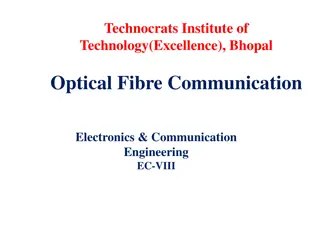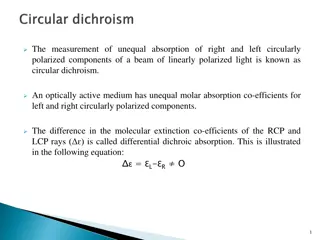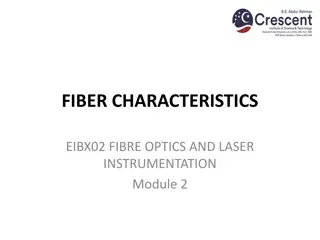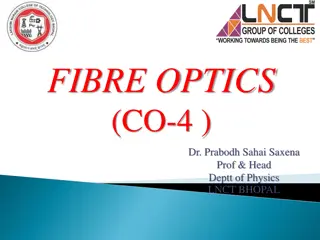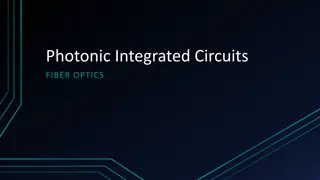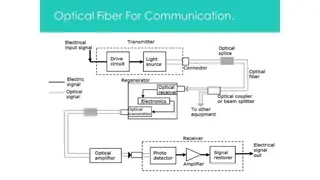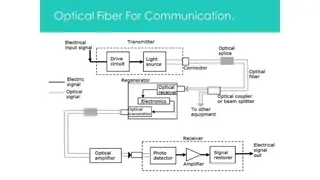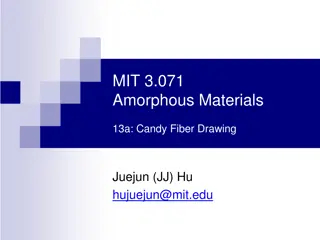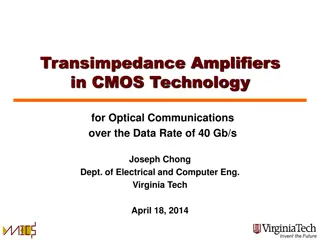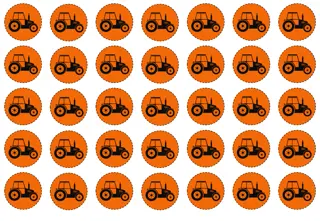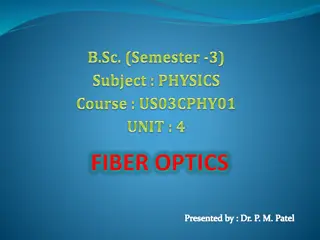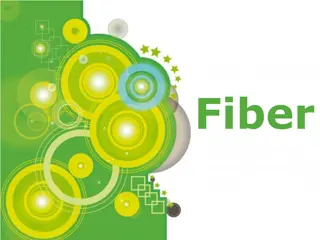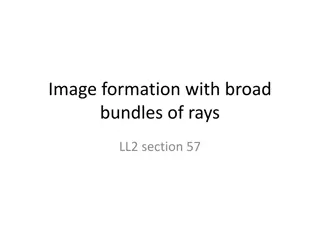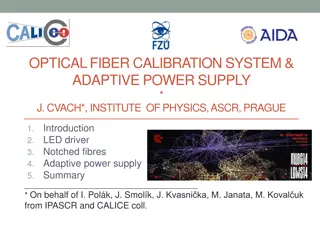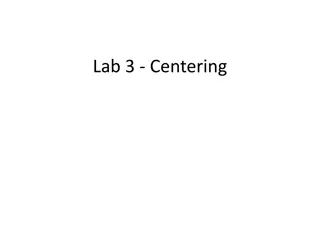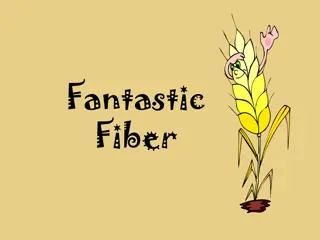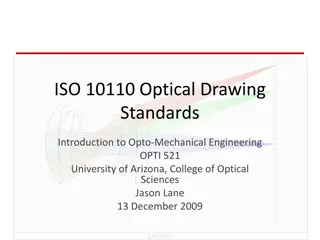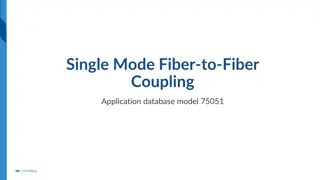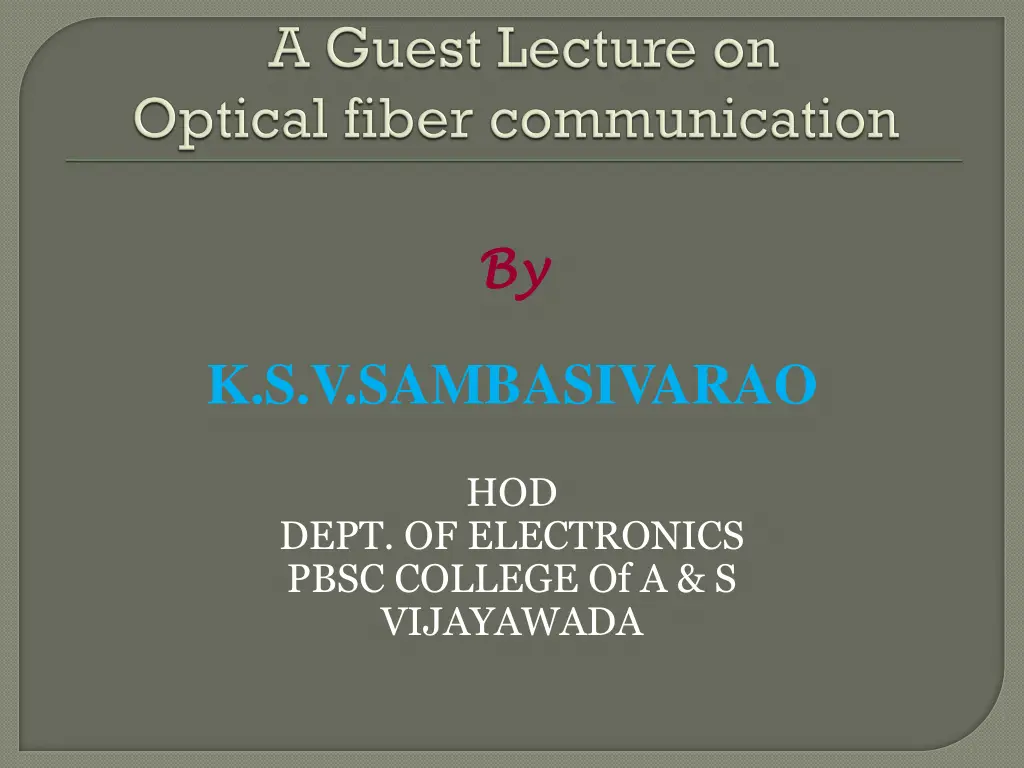
Advanced Communication Systems and Fiber Optic Technology
Explore the world of advanced communication systems and fiber optic technology, covering topics such as basic communication systems, optical wave guides, transmitter-receiver functions, message origins, and applications of fiber optic cables in various fields. Discover the advantages of fiber optic technology and its extensive use in telephone systems, cable TV, internet, military applications, medical imaging, and more.
Download Presentation

Please find below an Image/Link to download the presentation.
The content on the website is provided AS IS for your information and personal use only. It may not be sold, licensed, or shared on other websites without obtaining consent from the author. If you encounter any issues during the download, it is possible that the publisher has removed the file from their server.
You are allowed to download the files provided on this website for personal or commercial use, subject to the condition that they are used lawfully. All files are the property of their respective owners.
The content on the website is provided AS IS for your information and personal use only. It may not be sold, licensed, or shared on other websites without obtaining consent from the author.
E N D
Presentation Transcript
By By K.S.V.SAMBASIVARAO HOD DEPT. OF ELECTRONICS PBSC COLLEGE Of A & S VIJAYAWADA
INTRODUCTION BASIC COMMUNICATION SYSTEM BLOCK DAIGRAM ADVANTAGES APPLICATIONS OPTICAL WAVE GUIDES MODES SOURCE DETECTOR LOSSES IN FIBER
Fiber optic cables are used in telephone system, cable TV (or) internet They carry digital information over long distance They transmit light signals over long distance They can be used in military, submarines, medical imaging e.t.c, plastic jacket glass or plastic cladding fiber core Fiber Optical Inner View Medical
Electronics military
Transmitter: In this message is generated an put in suitable form Information channel: It is divided in two categories (i)unguided(ii)guided Receiver: The message is extracted from the channel and put in final form. Information channel Transmitter receiver
Message Origin: it is a transducer to convert electrical message in to proper format. Modulator: it perform two functions(i) convert electrical message to proper format(ii)it impress the signal wave generated by source Carrier Oscillator: carrier wave produced by electronic oscillator for fiber system i.e. LD,LED.
Channel Coupler: In radio/TV it acts like an antenna. Information Channel: It is a path between transmitter and receiver. It is used to boost up the power level of weak signal. Detector: In this optic wave convert in to electric current by photodiode. Signal Processing: In this two types of circuits are used (i)Amplifier (ii)Filter
Less expensive Thinner High carrying capacity Less signal degration Light signal Non-flammable Flexible Medical imaging Light weight
Telephone applications are wide spread ranging from global n/w to desktop computer It involves transmission of voice ,data (or) video over distances of less than a meter tom 100km. POTS(Plain old telephone service) across nation wide network LECS(Local exchange carries) central office switches at local levels In cable TV companies also used fiber for delivery of digital video(or) data services. It used in Bio-medical industry, Modern tele- medicine for transmission of digital diagnostic images.
Modes They are two types of modes (i) Single mode (ii) Multi mode Single mode: It has small cores (9 microns in diameter) and transmit infrared light and they propagate only in one direction Multi mode: It has large cores(62.5 microns in diameter) and transmit visible & infrared light rays. Multi-mode Single-mode
Step Index: The rays entering at different angles travel different paths and emerge out at the end of fiber at different times GRIN : The core has non uniform refractive index in any medium Materials : Glass core-Glass cladding Plastic core-Plastic cladding The size of fiber denoted by writing a core diameter that cladding diameter both in microns with a slash between them 50/125. Glass-long distance, Plastic-Short distance
It is of two types (i)LED (ii) LASER LED: It is a P-N junction semiconductor diode that emits light when it is forward bias. voltage drop will be 2 to 4 volts ,area is 1mm,current is 50-100ma,Low energy consumption, long life time, faster switching.
In this two types (i)He-Ne (ii)Nd:YAG He-Ne: It is coupled to bare fiber to detect break/cut and by using this NA can be measured. In this two types of emissions (i)Spontaneous:-Electrons drops from an excited state to a lower state emitting a photon (ii)Stimulated:-Photon interacts with electron in excited state which drops two lower state. Duration 10-8 seconds the atom stay in high state. 11 years in room temperature,&700 -10,000hours. of same frequency
Laser Diode He_Ne Laser Diode
In this photo detection mechanism are of two types External:- In which electrons are feed from the surface of a metal by the energy absorbed from an incident stream of photons. EX: Vacuum tube, PMT Internal:- The free charge carries electrons and holes are generated by absorption of incoming photons. Ex: PN,PIN,APD
Semi conductor:- They are small, light ,sensitive, fast and operate with a few bias volts For Emission the diode is forward bias the charges injected in the junction recombination to produce photons For detection the diode reverse bias to generate electron hole pair producing electric current. PIN: High resistance ,improve efficiency APD: It convert light to electricity, High reverse bias, Reverse voltage 100-200v,gain 105-106
PIN photodiode Vacuum tube
Attenuation: Loss of light energy as the light pulse travels from one end of cable to the other.-signal loss(or)fiber loss It also decide no. of repeaters required between transmitter and receiver. It directly proportional to length of cable.
Macroscopic: in which fiber undergo bends which causes certain modes not be reflected. Microscopic: Either core (or) cladding undergo slight bends at it s surface. Distortion Inter modal: Difference between modes with in multimode Intra modal: Pulse spreading that occurs in single mode Absorption Light energy due to heating of ion impurities results in dimming of light at the end of fiber (i)Intrinsic(ii)Extrinsic
Attenuation-cut back technique, OTDR Numerical aperture measurement (i)Scanning photo detector (ii)Vibration isolated granite slab Time division multiplexing Frequency division multiplexing Measurement losses in splice and connector Inter-ferometric method Outer diameter by shadow method

